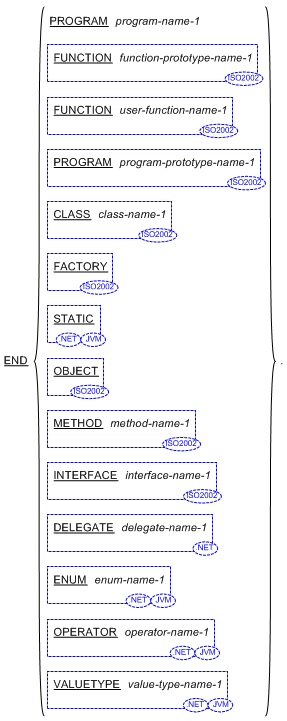End Markers
End markers indicate the end of a definition
General Format

Note: The Delegate-ID paragraph is not yet supported in COBOL for JVM.
Syntax Rules
- An end marker must be present in every source unit that contains, is contained in, or precedes another source unit.
- Program-name-1 must be identical to the program-name declared in a preceding Program-ID paragraph.
- If a Program-ID paragraph declaring a specific program-name is stated between the Program-ID paragraph and the END PROGRAM marker for program-name-1, then an END PROGRAM marker referencing program-name must precede the END PROGRAM marker referencing program-name-1.
- Function-prototype-name-1 must be identical to the function-prototype-name declared in the corresponding Function-ID paragraph.
- User-function-name-1 must be identical to the user-function-name declared in the corresponding Function-ID paragraph.
- Program-prototype-name-1 must be identical to the program-prototype-name declared in the corresponding Program-ID paragraph.
- Class-name-1 must be identical to the class-name declared in the corresponding Class-ID paragraph.
- Method-name-1 must be identical to the method-name declared in the corresponding Method-ID paragraph.
If the PROPERTY phrase is specified in the Method-ID paragraph, method-name-1 must be omitted.
- Interface-name-1 must be identical to the interface-name declared in the corresponding Interface-ID paragraph.
- If the source unit terminated by the end marker is contained within another source unit, the next statement must be either the first statement of a source unit or another end marker that terminates the containing source unit.
- If the source unit terminated by an end marker is not contained within another source unit, the next statement must be the first statement of a compilation unit.
General Rules
- An end marker indicates the end of the specified source unit.